- Last Updated: November 24th, 2025
Key Takeaways
PFAS contamination at military facilities primarily results from the use of aqueous film-forming foam (AFFF) in firefighting exercises. This leads to persistent environmental contamination by these "forever chemicals" and poses significant health risks for military personnel and their families.
Scientific studies have demonstrated a correlation between exposure to toxic PFAS chemicals and thyroid disease, with higher rates of thyroid disorders in populations exposed to elevated levels of PFAS.
Individuals affected by PFAS exposure can file personal injury claims on several legal grounds, including product liability, negligence, and failure to warn. Victims are entitled to various types of compensation related to PFAS claims, such as coverage for medical expenses, lost wages, and potentially punitive damages.
Overview of PFAS Thyroid Disease Lawsuit
On this page, we’ll provide an overview of the PFAS thyroid disease lawsuit, links between PFAS exposure and thyroid disease, how to file a PFAS thyroid disease lawsuit, and much more.
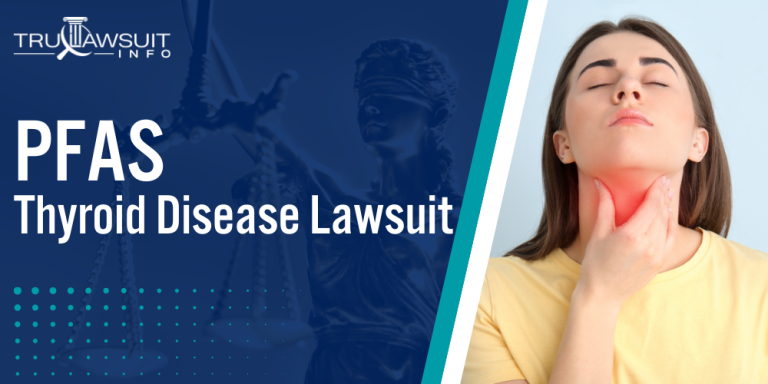
Intro to PFAS Thyroid Disease Lawsuit
Key aspects of the PFAS thyroid disease lawsuit include:
- Legal Grounds for Lawsuits: Victims can file lawsuits on grounds such as product liability, negligence, and failure to warn. Previous PFAS settlements have provided significant financial compensation for affected individuals.
- Sources of PFAS Contamination: Contamination at military bases primarily originates from the use of aqueous film-forming foam (AFFF) in firefighting, leading to persistent contamination in groundwater, soil, air, and indoor environments.
- Health Risks: PFAS exposure is linked to serious health effects, including thyroid dysfunction, increased risk of thyroid disease, and immune system effects.
If you or a loved one has developed thyroid disease or any other severe health conditions after being exposed to PFAS chemicals at a military base, you may be eligible for compensation.
Contact TruLawsuit Info using the chat on this page to receive an instant case evaluation to see if you qualify to file a PFAS thyroid disease lawsuit.
PFAS Contamination at Military Bases
Per- and polyfluoroalkyl substances (PFAS) are synthetic chemicals used in various industrial and consumer products.
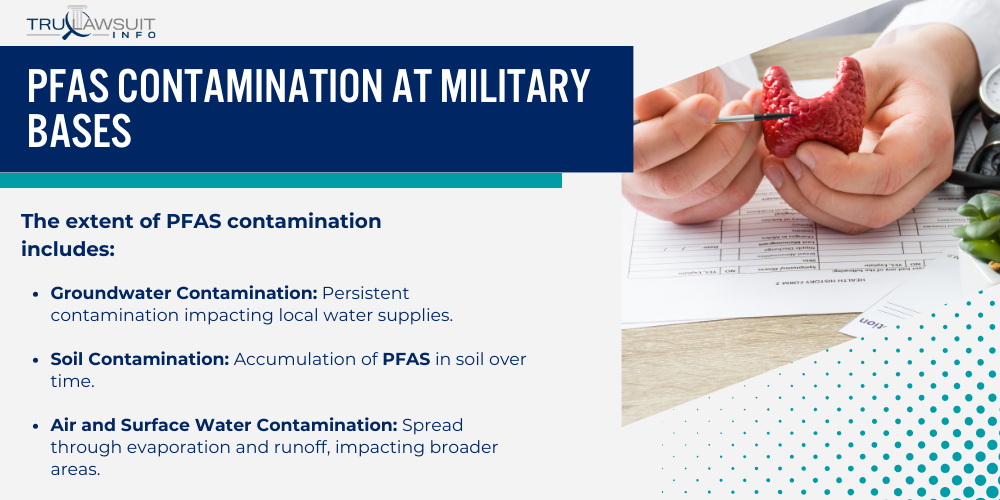
Military facilities have been significantly impacted by PFAS contamination due to the widespread use of firefighting foam.
This section outlines the sources and extent of PFAS contamination at military facilities and the health implications for military personnel.
Sources and Extent of PFAS Contamination at Military Facilities
PFAS contamination at military facilities primarily results from the use of aqueous film-forming foam (AFFF) in firefighting exercises and emergency responses.
These foams, containing high levels of PFAS, have led to persistent environmental contamination.
The extent of PFAS contamination includes:
- Groundwater Contamination: Persistent contamination impacting local water supplies.
- Soil Contamination: Accumulation of PFAS in soil over time.
- Air and Surface Water Contamination: Spread through evaporation and runoff, impacting broader areas.
These contamination sources present long-term environmental and health concerns for military personnel and their families.
Health Implications of PFAS Exposure for Military Personnel
Exposure to PFAS in military environments has been linked to various adverse health impacts.
Military personnel face significant health risks due to prolonged exposure to contaminated drinking water and soil.
Health risks associated with PFAS exposure include thyroid dysfunction, increased likelihood of various cancers, and immune system effects.
Continued research and monitoring are essential to fully understand and mitigate the health risks posed by PFAS contamination at military facilities.
Impact of PFAS on Military Families and Personnel
The impact of PFAS exposure on military personnel and their families is significant, affecting their health and well-being in multiple ways.
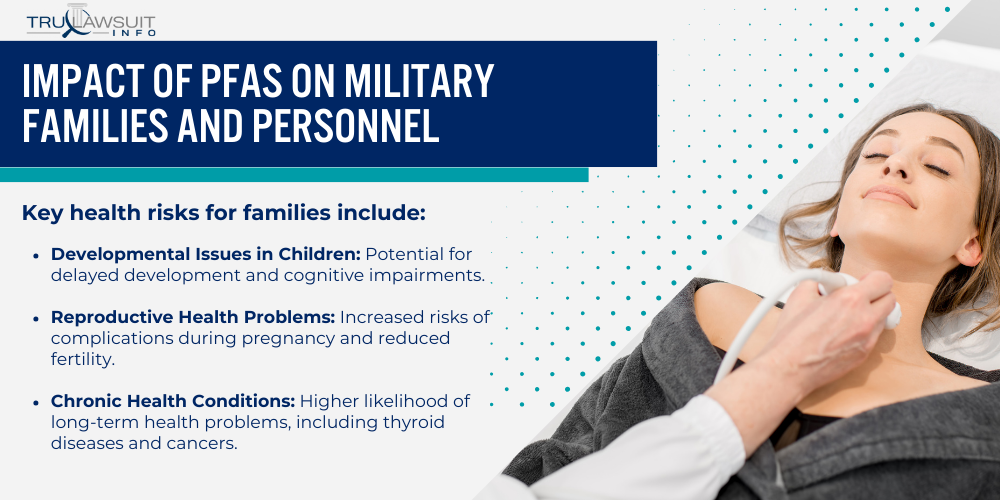
This section explores the specific health effects of PFAS exposure on military members and the risks faced by their families living near contaminated water supplies.
Effects of PFAS Exposure on Military Members
Military members are particularly vulnerable to PFAS exposure due to the nature of their duties and prolonged presence on contaminated bases.
The health effects can be severe and long-lasting, impacting their overall quality of life and ability to serve.
Increased risks of cancer, including kidney cancer, endocrine disruption, and immune system impairment, are primary health concerns for military personnel.
These health effects not only affect their personal well-being but also their professional performance and readiness.
Risks to Families Living Near Contaminated Military Bases
Families residing on or near contaminated military bases are also at risk of PFAS exposure through various environmental pathways.
This exposure can have significant health implications, particularly for vulnerable groups such as children and pregnant women.
Key health risks for families include:
- Developmental Issues in Children: Potential for delayed development and cognitive impairments.
- Reproductive Health Problems: Increased risks of complications during pregnancy and reduced fertility.
- Chronic Health Conditions: Higher likelihood of long-term health problems, including thyroid diseases and cancers.
Addressing these risks is crucial for protecting the health and well-being of military families.
Connection Between PFAS Exposure and Thyroid Disease
The connection between PFAS exposure and thyroid disease has garnered significant scientific interest.
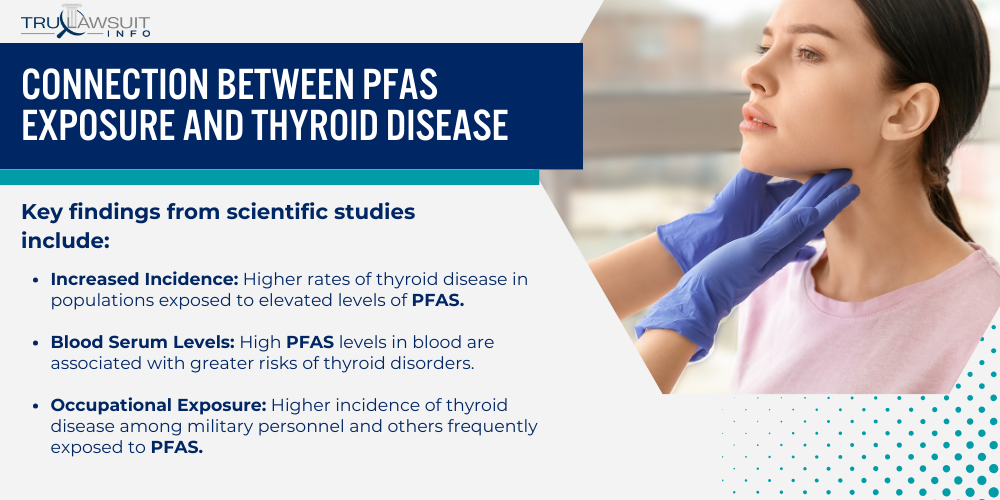
Numerous studies have investigated how these toxic chemicals interact with the human body, particularly focusing on their potential to induce thyroid diseases.
Scientific Studies Linking PFAS to Thyroid Disease
Several scientific studies have demonstrated a correlation between PFAS exposure and an increased risk of thyroid disease.
Research indicates that individuals with higher levels of PFAS in their blood are more likely to develop thyroid disorders.
Key findings from scientific studies include:
- Increased Incidence: Higher rates of thyroid disease in populations exposed to elevated levels of PFAS.
- Blood Serum Levels: High PFAS levels in blood are associated with greater risks of thyroid disorders.
- Occupational Exposure: Higher incidence of thyroid disease among military personnel and others frequently exposed to PFAS.
These studies provide compelling evidence for the potential of PFAS to contribute to the development of thyroid disease.
Mechanisms of PFAS in Thyroid Disease Development
The mechanisms by which PFAS contributes to thyroid disease development are complex.
PFAS chemicals can interfere with thyroid hormone regulation and disrupt normal cellular functions, leading to thyroid diseases.
PFAS are known to bind to proteins and accumulate in the thyroid gland, where they can alter hormone production and signaling pathways.
This disruption can lead to the development of thyroid disease.
Legal Basis for PFAS Thyroid Disease Lawsuits
The legal basis for PFAS thyroid disease lawsuits is grounded in tort law principles, focusing on product liability, negligence, and environmental contamination.
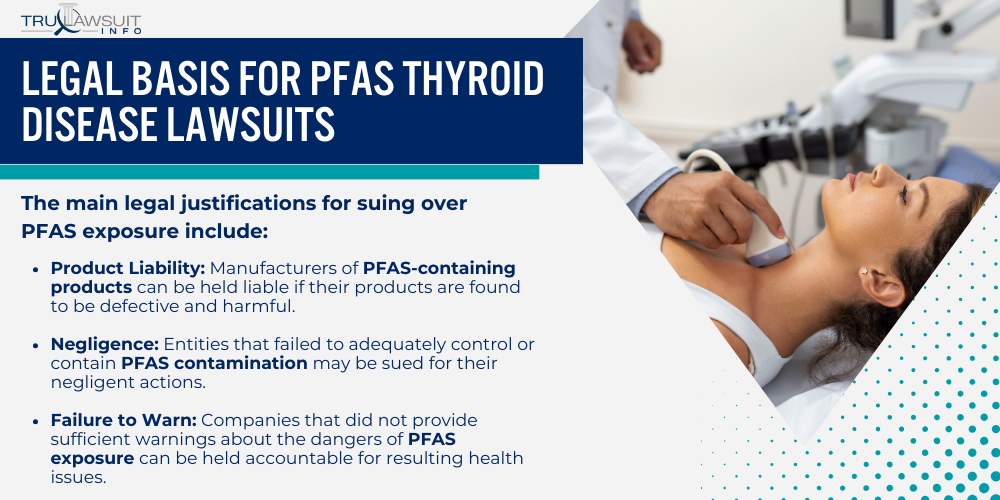
Victims of PFAS exposure who develop thyroid disease can seek compensation for their injuries.
This section outlines the legal justifications for suing over PFAS exposure and reviews previous lawsuits and their outcomes.
Legal Justifications for Suing Over PFAS Exposure
Individuals affected by PFAS exposure can file lawsuits on several legal grounds, including product liability, negligence, and failure to warn.
The main legal justifications for suing over PFAS exposure include:
- Product Liability: Manufacturers of PFAS-containing products can be held liable if their products are found to be defective and harmful.
- Negligence: Entities that failed to adequately control or contain PFAS contamination may be sued for their negligent actions.
- Failure to Warn: Companies that did not provide sufficient warnings about the dangers of PFAS exposure can be held accountable for resulting health issues.
These legal justifications provide a foundation for affected individuals to seek justice and compensation for their injuries.
Previous Outcomes of PFAS Thyroid Disease Lawsuits
Numerous PFAS lawsuits have been filed in recent years, with various outcomes.
Some cases have led to significant financial settlements, while others have prompted regulatory changes and increased awareness of PFAS-related health risks.
Notable outcomes of previous PFAS lawsuits include large settlements with chemical manufacturers, compensation for affected individuals, and the establishment of medical monitoring programs.
These outcomes highlight the importance of holding responsible parties accountable and provide precedents for future litigation.
Filing a PFAS Thyroid Disease Lawsuit
Filing a PFAS thyroid disease lawsuit involves several critical steps to ensure that the claim is properly documented and presented.
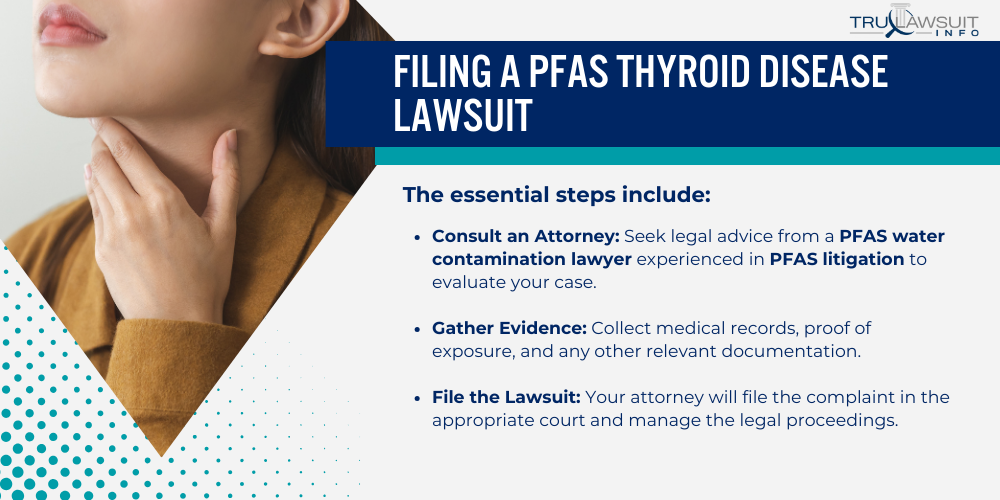
Affected individuals must gather substantial evidence and follow legal procedures to maximize their chances of a successful outcome.
This section details the steps to take when filing a PFAS thyroid disease lawsuit and the essential evidence and documentation required.
Steps for Initiating a PFAS Thyroid Disease Legal Action
Filing a PFAS thyroid disease lawsuit requires careful planning and adherence to legal processes.
The initial steps involve consulting with a specialized attorney, gathering evidence, and filing the necessary legal documents.
The essential steps include:
- Consult an Attorney: Seek legal advice from a PFAS water contamination lawyer experienced in PFAS litigation to evaluate your case.
- Gather Evidence: Collect medical records, proof of exposure, and any other relevant documentation.
- File the Lawsuit: Your attorney will file the complaint in the appropriate court and manage the legal proceedings.
Following these steps ensures that your case is well-prepared and has a solid foundation for legal action.
Key Evidence for a PFAS Thyroid Disease Lawsuit
Successful PFAS thyroid disease lawsuits rely heavily on comprehensive evidence and documentation.
This evidence supports the claim that PFAS exposure causes thyroid disease and justifies the demand for compensation.
Important evidence includes medical records detailing the diagnosis and treatment of thyroid disease, proof of PFAS exposure (such as water testing results and military service records), and expert testimonies linking PFAS exposure to the disease.
Collecting thorough and detailed documentation strengthens the case and increases the likelihood of a favorable outcome.
Challenges and Defenses in PFAS Lawsuits
PFAS thyroid disease lawsuits can be complex, often involving various legal and scientific challenges.
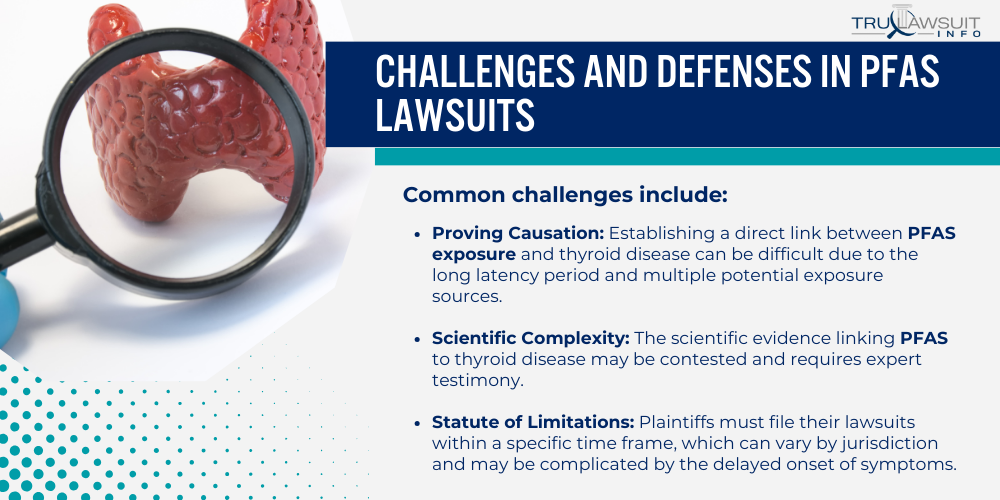
Plaintiffs must navigate these obstacles to build a compelling case against manufacturers and other responsible parties.
This section discusses the common challenges faced in PFAS thyroid disease lawsuits and the potential defenses used by PFAS manufacturers.
Common Obstacles in PFAS Thyroid Disease Lawsuits
Filing a PFAS thyroid disease lawsuit involves overcoming several significant challenges.
These challenges can complicate the legal process and affect the outcome of the case.
Common challenges include:
- Proving Causation: Establishing a direct link between PFAS exposure and thyroid disease can be difficult due to the long latency period and multiple potential exposure sources.
- Scientific Complexity: The scientific evidence linking PFAS to thyroid disease may be contested and requires expert testimony.
- Statute of Limitations: Plaintiffs must file their lawsuits within a specific time frame, which can vary by jurisdiction and may be complicated by the delayed onset of symptoms.
Successfully addressing these challenges is crucial for plaintiffs seeking justice and compensation.
Defense Tactics by PFAS Manufacturers
PFAS manufacturers often employ various defenses to counter lawsuits and minimize their liability.
Understanding these potential defenses can help plaintiffs and their attorneys prepare stronger cases.
Manufacturers may argue that the plaintiff’s thyroid disease was caused by factors other than PFAS exposure, such as genetic predisposition or other environmental exposures.
They might also challenge the validity of scientific studies linking PFAS to thyroid disease or claim that they complied with existing regulations and industry standards at the time of PFAS use.
Additionally, they may invoke statutes of limitations to argue that the lawsuit was filed too late.
Countering these defenses requires robust evidence and expert testimony to substantiate the claims of PFAS-induced thyroid disease.
Future Regulation and Legal Trends for PFAS
The future of PFAS regulation and legal actions is likely to see significant developments as awareness of the health risks associated with these chemicals continues to grow.
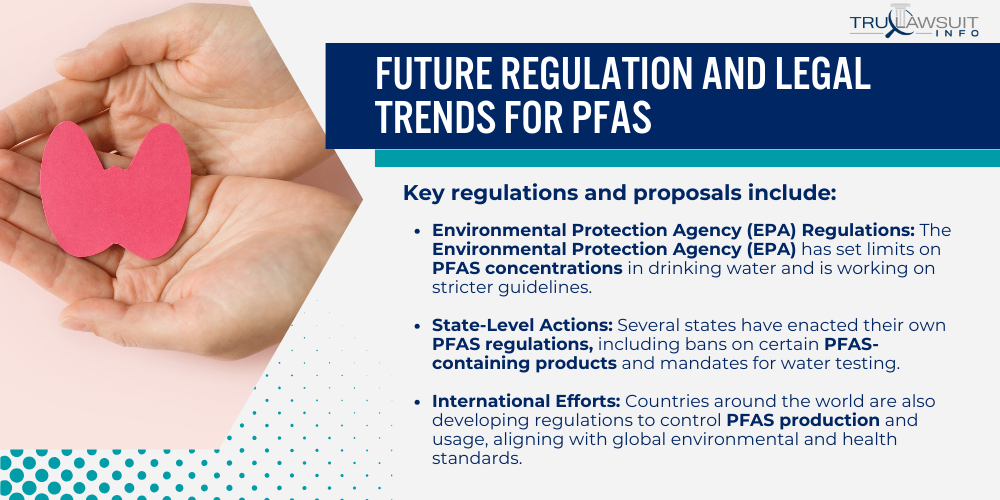
Regulatory agencies and lawmakers increasingly focus on addressing PFAS contamination and holding manufacturers accountable.
This section explores current and proposed regulations on PFAS and future trends and legal developments in PFAS litigation.
Current and Proposed PFAS Regulations
Regulatory agencies have begun implementing and proposing measures to reduce PFAS contamination and protect public health.
These regulations are critical in managing the widespread impact of PFAS and ensuring safer environments.
Key regulations and proposals include:
- Environmental Protection Agency (EPA) Regulations: The Environmental Protection Agency (EPA) has set limits on PFAS concentrations in drinking water and is working on stricter guidelines.
- State-Level Actions: Several states have enacted their own PFAS regulations, including bans on certain PFAS-containing products and mandates for water testing.
- International Efforts: Countries around the world are also developing regulations to control PFAS production and usage, aligning with global environmental and health standards.
These regulatory efforts are essential steps toward reducing PFAS exposure and preventing further contamination.
Future Trends in PFAS Litigation
The landscape of PFAS litigation is evolving, with increasing numbers of lawsuits and more comprehensive legal strategies.
Future trends in PFAS litigation are expected to focus on holding more entities accountable and expanding the scope of legal actions.
As scientific evidence linking PFAS to various health conditions strengthens, we can anticipate a rise in individual and PFAS class action lawsuits.
Legal strategies will likely become more sophisticated, with plaintiffs’ attorneys leveraging new research and expert testimony to build stronger cases.
Additionally, there may be greater collaboration between federal and state agencies to address PFAS contamination comprehensively.
These trends suggest that PFAS litigation will continue to grow, potentially leading to more substantial settlements and regulatory changes.
TruLawsuit Info: Maximizing Your PFAS Thyroid Disease Lawsuit Settlement
Maximizing the success of your PFAS thyroid disease lawsuit requires strategic legal representation and a thorough understanding of the types of compensation available.
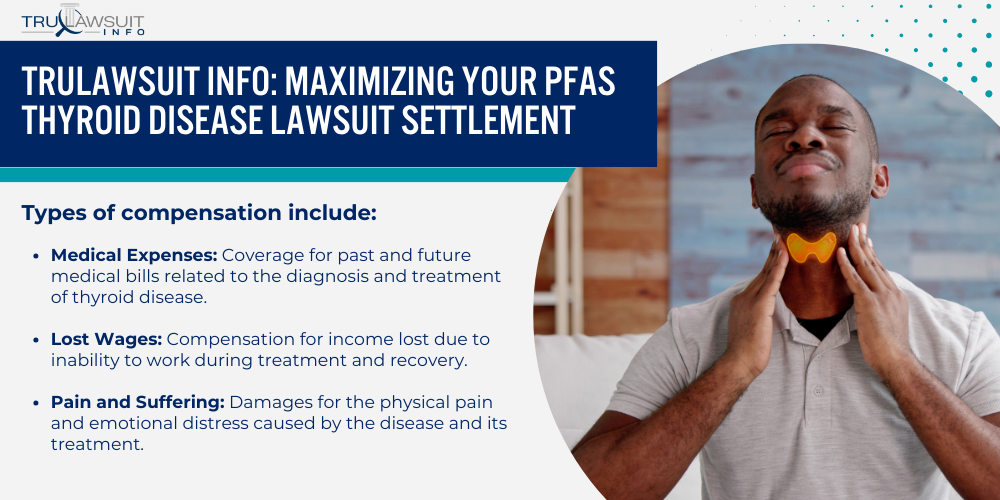
TruLaw offers expert guidance and resources to help plaintiffs achieve the best possible outcomes.
This section outlines the types of compensation available for PFAS thyroid disease victims and explains the benefits of a contingency fee basis with instant case evaluation.
Compensation Available for PFAS Thyroid Disease Victims
Victims of PFAS thyroid disease are entitled to various types of compensation to address the physical, emotional, and financial impact of their condition.
Understanding the full scope of compensation can help plaintiffs seek adequate redress for their suffering.
Types of compensation include:
- Medical Expenses: Coverage for past and future medical bills related to the diagnosis and treatment of thyroid disease.
- Lost Wages: Compensation for income lost due to inability to work during treatment and recovery.
- Pain and Suffering: Damages for the physical pain and emotional distress caused by the disease and its treatment.
- Punitive Damages: In cases of egregious misconduct by manufacturers, additional damages may be awarded to punish the responsible parties.
This comprehensive compensation aims to alleviate the burden on victims and provide them with the necessary support.
Contingency Fee Basis: Instant PFAS Lawsuit Evaluation
TruLaw operates on a contingency fee basis, which means clients do not pay any upfront fees for legal services.
Instead, attorneys receive a percentage of the settlement or award only if the case is successful.
This approach ensures that legal representation is accessible to all victims, regardless of their financial situation.
The process begins with an instant case evaluation, where potential plaintiffs can quickly determine the viability of their lawsuit.
TruLaw’s experienced attorneys review the case details, assess the evidence, and provide guidance on the best course of action.
This initial evaluation helps victims understand their legal options and the potential for a successful outcome, ensuring they can make informed decisions about pursuing litigation.
Frequently Asked Questions
-
While several class action lawsuits related to PFAS have occurred in the past, multidistrict litigation (MDL) centralized in the District of South Carolina is currently consolidating lawsuits related to PFAS contamination across 20 different federal district courts.
-
The primary source of PFAS contamination at military facilities is the use of aqueous film-forming foam (AFFF) in firefighting exercises and emergency responses.
These foams contain high levels of PFAS, leading to persistent environmental contamination in groundwater, soil, air, and surface water.
-
Military personnel face significant health risks due to prolonged exposure to PFAS-contaminated drinking water and soil, including increased risks of cancer, endocrine disruption, and immune system impairment.
Families residing near contaminated military bases are also at risk of PFAS exposure.
-
Several scientific studies have demonstrated a correlation between PFAS exposure and an increased risk of thyroid disease, with higher rates of thyroid disorders in populations exposed to elevated levels of PFAS.
The mechanisms by which PFAS contributes to thyroid disease development involve the chemicals interfering with thyroid hormone regulation and disrupting normal cellular functions.
-
Individuals affected by PFAS exposure can file lawsuits on several legal grounds, including product liability (if PFAS-containing products are found to be defective and harmful), negligence (if entities failed to control or contain PFAS contamination), and failure to warn (if companies did not provide sufficient warnings about the dangers of PFAS exposure).
-
Victims of PFAS thyroid disease are entitled to various types of compensation, including coverage for past and future medical expenses, lost wages due to inability to work during treatment and recovery, damages for pain and suffering caused by the disease and its treatment, and potentially punitive damages in cases of egregious misconduct by manufacturers.

Attorney Jessie Paluch, founder of TruLawsuit Info, has over 25 years of experience as a personal injury and mass tort attorney, and previously worked as an international tax attorney at Deloitte. Jessie collaborates with attorneys nationwide — enabling her to share reliable, up-to-date legal information with our readers.
Legally Reviewed
This article has been written and reviewed for legal accuracy and clarity by the team of writers and legal experts at TruLawsuit Info and is as accurate as possible. This content should not be taken as legal advice from an attorney. If you would like to learn more about our owner and experienced injury lawyer, Jessie Paluch, you can do so here.
Fact-Checked
TruLawsuit Info does everything possible to make sure the information in this article is up to date and accurate. If you need specific legal advice about your case, contact our team by using the chat on the bottom of this page. This article should not be taken as advice from an attorney.
You can learn more about the PFAS Contamination Lawsuit by visiting any of our pages listed below:
Here, at Tru Lawsuit Info, we’re committed to helping victims get the justice they deserve.
To do this, we actively work to connect them with attorneys who are experts in litigating cases similar to theirs.
Table of Contents
Tru Lawsuit Info is a reliable source of information about issues that may affect your health and safety, such as faulty products, data breaches, and environmental hazards.
Our team of experienced writers collaborates with medical professionals, lawyers, and advocates to produce informative articles, guides, and other resources that raise awareness of these topics.
Our thorough research provides consumers with access to reliable information and updates on lawsuits happening around the country. We also can connect consumers with attorneys if they need assistance.
Here, at Tru Lawsuit Info, we’re committed to helping victims get the justice they deserve.
To do this, we actively work to connect them with attorneys who are experts in litigating cases similar to theirs.
